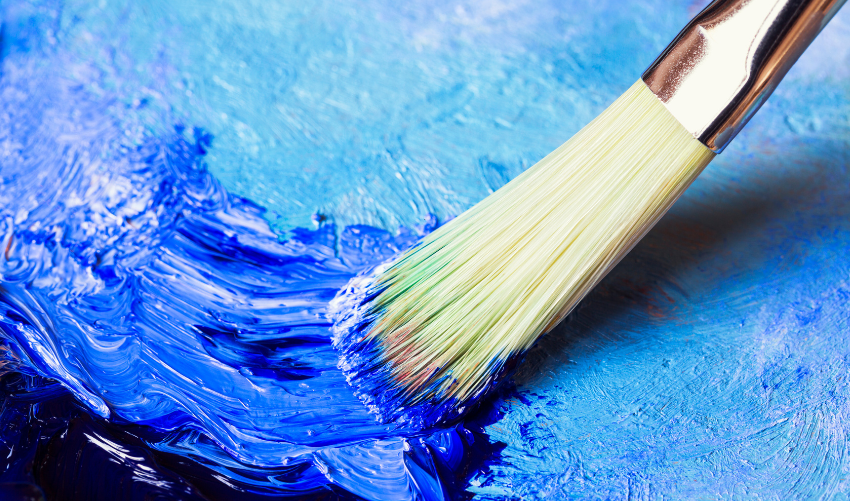Whether you’re an artist looking to deepen your palette or a DIY enthusiast wanting to add flair to your projects, understanding Ultramarine Blue is essential. You’ll discover the unique characteristics of this captivating color, explore its various shades, and learn practical tips on how to use it effectively.
What Is Ultramarine Blue?
Ultramarine Blue is a popular pigment used in art and design. It has a rich history and unique qualities. Artists love its vibrant color and versatility. In this section, we will explore what Ultramarine Blue is and its characteristics.
Ultramarine Blue is a deep blue pigment. It is made from the mineral lapis lazuli. This pigment has been used since ancient times. Its name comes from the Latin word “ultra,” meaning beyond, and “marinus,” meaning sea. This reflects its stunning blue color, similar to the ocean.
It was first made from lapis lazuli in Afghanistan. The pigment was highly valued. It was more expensive than gold. Artists used it for important works, like religious paintings.
Characteristics Of Ultramarine Blue
- Vibrant Color: It has a bright and striking hue.
- Lightfastness: It is resistant to fading over time.
- Opacity: Ultramarine Blue can cover surfaces well.
- Mixing: It mixes well with other colors.
Variations Of Ultramarine Blue
There are several variations of Ultramarine Blue. Each has its own unique properties:
| Variation | Description |
|---|---|
| Ultramarine Blue (Green Shade) | A cooler, more turquoise hue. |
| Ultramarine Blue (Red Shade) | A warmer, more violet hue. |
| Synthetic Ultramarine | A modern version, more affordable and consistent. |
Uses Of Ultramarine Blue
Ultramarine Blue is used in various fields:
- Painting and Fine Arts
- Textiles and Fabrics
- Cosmetics and Personal Care
- Plastics and Coatings
This pigment continues to inspire artists today. Its beauty and versatility make it a favorite choice.
History Of Ultramarine Blue
This vibrant blue hue has roots that trace back to ancient civilizations. Its unique beauty and rarity made it a symbol of wealth and prestige. Understanding the history of Ultramarine Blue reveals its journey from a precious mineral to a widely used pigment.

Origins Of Ultramarine Blue
Ultramarine Blue originated from the mineral lapis lazuli. This stone was mined mainly in Afghanistan. It was highly valued for its deep blue color. Ancient Egyptians, Greeks, and Romans used it in their art and decoration.
Medieval Europe And The Renaissance
During the Middle Ages, Ultramarine Blue became more popular in Europe. It was often used in religious paintings. Artists believed the color symbolized divine qualities. The pigment was extremely expensive due to its labor-intensive extraction process.
In the Renaissance, artists like Michelangelo and Raphael used Ultramarine Blue to enhance their works. Its vibrancy added depth and emotion to their pieces. The pigment became a staple in the palettes of many famous painters.
Creation Of Synthetic Ultramarine
The demand for Ultramarine Blue led to the search for a more affordable alternative. In the 19th century, chemists developed synthetic Ultramarine. This new pigment maintained the same bright hue but was cheaper to produce.
Synthetic Ultramarine quickly became popular among artists and manufacturers. It was used in various applications, from painting to textiles. Today, both natural and synthetic forms of Ultramarine Blue are widely available.
Modern Use And Significance
Today, Ultramarine Blue remains a favorite among artists. Its vibrant color and versatility make it suitable for various mediums. Painters, designers, and decorators often choose it for their projects.
- Watercolors
- Oil paints
- Acrylics
Its rich history adds to its allure. Understanding this pigment connects artists to the past. Ultramarine Blue continues to inspire creativity and expression.
Types Of Ultramarine Blue
Different types of ultramarine blue exist, each with its own characteristics. Understanding these types can help you choose the right one for your project. Let’s explore the two main types: Natural Ultramarine and Synthetic Ultramarine.
Natural Ultramarine
Natural ultramarine blue is a pigment made from the mineral lapis lazuli. This mineral has been used for centuries, dating back to ancient Egypt. The process of creating natural ultramarine is complex and labor-intensive. It involves grinding lapis lazuli into a fine powder. The powder is then treated with alkaline substances to produce the deep blue color.
Key features of natural ultramarine include:
- Color Quality: Deep and vibrant blue.
- Lightfastness: Excellent resistance to fading.
- Opacity: Semi-opaque, allowing for layering effects.
Natural ultramarine is often used in:
- Fine art painting.
- Restoration work.
- Decorative arts.
Here is a comparison of natural ultramarine with other blue pigments:
| Pigment | Color Intensity | Lightfastness | Price |
|---|---|---|---|
| Natural Ultramarine | High | Excellent | High |
| Cobalt Blue | Moderate | Very Good | Moderate |
| Phthalo Blue | Very High | Excellent | Low |
Due to its cost and availability, natural ultramarine is less common today. Yet, it remains a favorite for artists seeking authenticity and depth in their work.
Synthetic Ultramarine
Synthetic ultramarine blue is a modern alternative to natural ultramarine. It was first created in the early 19th century. This pigment is made from sodium, aluminum, and silicate. The manufacturing process is less costly than sourcing lapis lazuli. This makes synthetic ultramarine more accessible to artists and manufacturers.
Benefits of synthetic ultramarine include:
- Cost: More affordable than natural ultramarine.
- Color Consistency: Uniform color across batches.
- Versatility: Suitable for various applications.
Synthetic ultramarine is commonly used in:
- Oil and acrylic paints.
- Plastics and textiles.
- Cosmetics.
Here’s a quick comparison of synthetic ultramarine with natural ultramarine:
| Feature | Synthetic Ultramarine | Natural Ultramarine |
|---|---|---|
| Production Method | Manufactured | Natural mineral |
| Cost | Low | High |
| Color Quality | Vivid | Deep |
Synthetic ultramarine offers many advantages. It is an excellent choice for artists who need a reliable and economical blue pigment.
Color Variations
This section explores the different color variations of ultramarine blue. Understanding these variations helps in choosing the right shade for your project. Each variation has unique qualities that can enhance your artwork.
Ultramarine Deep
Ultramarine Deep is a rich and intense shade. It has a bold, strong presence on the canvas. This shade offers a deep blue with hints of violet. Artists often use it for shadows and dramatic effects.
Key features of Ultramarine Deep:
- Strong tinting strength
- Highly opaque
- Good lightfastness
- Mixes well with other colors
When using Ultramarine Deep, consider these tips:
- Use it for creating depth in landscapes.
- Combine it with white for lighter shades.
- Mix with yellows for vibrant greens.
Here’s a simple comparison table:
| Feature | Ultramarine Deep |
|---|---|
| Tinting Strength | High |
| Opacity | Opaque |
| Lightfastness | Excellent |
Ultramarine Light
Ultramarine Light is a softer and more delicate shade. It has a lighter, airy feel compared to Ultramarine Deep. This variation is great for creating soft skies or gentle waters.
Characteristics of Ultramarine Light include:
- Lower tinting strength
- Translucent quality
- Good mixability
To make the most of Ultramarine Light, try these techniques:
- Layer it with white for pastel effects.
- Use it in washes for gentle backgrounds.
- Combine with darker blues for contrast.
Here’s a comparison table:
| Feature | Ultramarine Light |
|---|---|
| Tinting Strength | Low |
| Opacity | Translucent |
| Lightfastness | Good |
Ultramarine Violet
Ultramarine Violet offers a unique twist on the traditional ultramarine blue. This shade combines blue and violet tones, creating a stunning effect. It is ideal for floral paintings and creative abstract work.
Important features of Ultramarine Violet:
- Rich, vibrant hue
- Good tinting strength
- Great for mixing purples
Tips for using Ultramarine Violet:
- Mix with white for lighter lavender shades.
- Combine with yellow for striking oranges.
- Use it to add depth in portraiture.
Here’s a comparison table:
| Feature | Ultramarine Violet |
|---|---|
| Tinting Strength | Medium |
| Opacity | Opaque |
| Lightfastness | Very Good |
Uses In Art
Ultramarine blue is a vibrant pigment known for its deep, rich color. Artists have used it for centuries. Its unique hue adds depth and emotion to artwork. Understanding its uses in art enhances creativity.
Painting Techniques
Ultramarine blue shines in various painting techniques. Artists appreciate its versatility. Here are some popular methods:
- Watercolor: Use ultramarine for washes. Its transparency allows for layering.
- Oil Painting: Mix with mediums like linseed oil. This enhances its richness.
- Acrylics: Perfect for bold strokes. It dries quickly and retains vibrancy.
Each technique brings out different qualities of ultramarine blue. Consider the following tips for best results:
- Start with a small amount. Add more as needed.
- Experiment with brush types. Different brushes create varied textures.
- Use a palette knife for thick applications.
Here is a simple table comparing techniques:
| Technique | Best Use | Characteristics |
|---|---|---|
| Watercolor | Soft backgrounds | Translucent and fluid |
| Oil Painting | Rich textures | Deep and glossy |
| Acrylics | Bold statements | Fast-drying and vibrant |
Mixing With Other Colors
Mixing ultramarine blue with other colors opens up new possibilities. It blends well and creates stunning shades. Here are some popular combinations:
- Ultramarine and Yellow: Creates vibrant greens.
- Ultramarine and White: Softens the blue for pastel tones.
- Ultramarine and Red: Produces purples and violets.
These mixtures can enhance your palette. Keep these tips in mind:
- Start with a base color. Gradually add ultramarine blue.
- Test mixtures on scrap paper.
- Adjust ratios for desired intensity.
Here is a quick reference table for mixing:
| Color Combination | Resulting Color |
|---|---|
| Ultramarine + Yellow | Bright Green |
| Ultramarine + White | Sky Blue |
| Ultramarine + Red | Purple |
Experiment with these combinations. Discover how ultramarine blue enhances your artwork.




